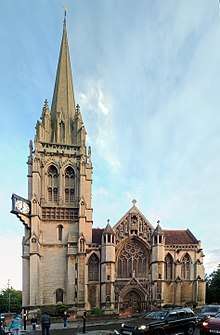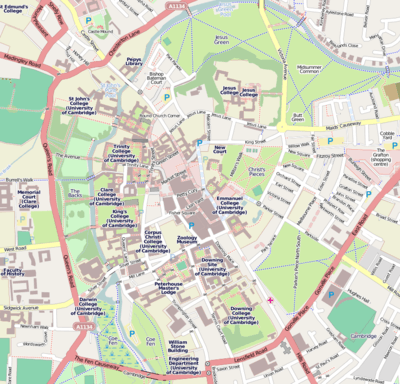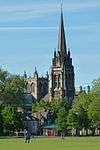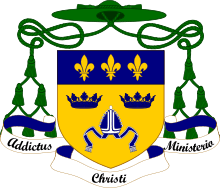Our Lady and the English Martyrs Church
The Church of Our Lady of the Assumption and the English Martyrs, also known as the Church of Our Lady and the English Martyrs (OLEM), is an English Roman Catholic parish church located at the junction of Hills Road and Lensfield Road in southeast Cambridge. It is a large Gothic Revival church built between 1885 and 1890.[1]
| Church of Our Lady and the English Martyrs | |
|---|---|
| Church of Our Lady of the Assumption and the English Martyrs | |
 The front (north side) of the church, from across Lensfield Rd. | |
 Church of Our Lady and the English Martyrs | |
| Location | Hills Road Cambridge CB2 1JR |
| Country | United Kingdom |
| Denomination | Roman Catholic |
| Website | www |
| History | |
| Status | Parish church |
| Dedication | Our Lady of the Assumption & the English Martyrs |
| Consecrated | 8 October 1890 |
| Relics held | Saints Felix and Constantia |
| Architecture | |
| Functional status | Active |
| Architect(s) | Dunn & Hansom |
| Style | Gothic Revival |
| Years built | 1885–1890 (by Rattee and Kett) |
| Specifications | |
| Length | Interior: 48 metres (157 ft) |
| Number of spires | 1 |
| Spire height | 65 metres (213 ft) |
| Materials | Limestone (Casterton, Ancaster, Combe Down)[1] |
| Administration | |
| Parish | Our Lady and the English Martyrs |
| Diocese | East Anglia |
| Province | Westminster |
| Clergy | |
| Rector | Mgr Eugène Harkness |
| Laity | |
| Director of music | Nigel Kerry |
Foundation
The first post-reformation Roman Catholic church was opened in Cambridge in 1841; St Andrew's Catholic Church (later dismantled and re-built in St Ives) remained the only chapel available for Roman Catholics in Cambridge until the construction of OLEM. In 1865, the parish priest Canon Thomas Quinlivan acquired additional adjacent land, but the funds could not be raised for construction. With the aid of the Duke of Norfolk, the entire Lensfield estate was purchased in 1879. The task of raising more funds fell to Quinlivan's successor, Mgr Christopher Scott. On the Feast of the Assumption, 1884, the former ballerina Yolande Lyne-Stephens, widow of Stephens Lyne-Stephens, who was reputed to be the richest commoner in England, offered to provide the £70,000 for the construction of a church on the site[2] (equivalent to £7.5 million in 2016[3]).
The building work was undertaken by Rattee and Kett,[4] and began in 1885, following the plans of the architects Dunn and Hansom, and the foundation stone was laid in June 1887. The construction of a new Roman Catholic church on such a prominent site, as well as its dedication to the Forty Martyrs of England and Wales, caused much controversy among local Anglicans and members of the University. Despite this, and the ill health of Mrs Lyne-Stephens, the church was completed and then consecrated on 8 October 1890. The first Mass was attended by all the Roman Catholic bishops of England and Wales except for Cardinal Manning and Bishop Vaughan.[2]
History
After its opening, the church saw a great rise in the number of Catholics in the parish. This was partly due to Fr Robert Benson's reputation as a preacher, as well as Mgr Scott's work as parish priest. OLEM also hosted the 1921 Bible Congress, the greatest Catholic gathering in Cambridge since the English Reformation. Between 1922 and 1946, the church was used by the Cambridge Summer School of Catholic Studies.[5]
In a 1941 air raid, a small bomb struck the sacristy, blowing a six-foot hole in the roof and another in the wall of the Sacred Heart chapel. The blast also shattered most of the windows and collapsed part of the organ gallery. The repairs, including replacement windows to the original designs, cost at least £35,000 (equivalent to £1.3 million in 2016[3]).[5]
Architecture
The building, one of the largest Catholic churches in the United Kingdom, is designed in the Gothic revival style and follows the traditional cruciform layout.[5] It features a polygonal apse and a central lantern tower. The construction includes Casterton stone for the foundation, Ancaster for the plinth, and the remainder in Combe Down. The interior is constructed in Bath stone, Plymouth marble and Newbiggin stone. The spire, the tallest in Cambridge, reaches 214 feet (65 m) and can be seen for a distance of several miles.[5]
The stained glass windows depict, among other things, dedications of Cambridge Colleges and scenes from the lives of English martyrs, in particular St John Fisher.[5]
To bring the sanctuary in line with the liturgical directives resulting from the Second Vatican Council (1962-1965), its design and re-ordering was done by Gerard Goalen of Harlow. On 7 April 1973, Charles Grant, the Bishop of Northampton, consecrated the present central altar. The original high altar has subsequently been used mainly for reservation of the Blessed Sacrament.[1]
The church is a Grade II* listed building.[6]
Rectory
The rectory is immediately to the south of the church and dates from around 1890. It is in the Tudor style, of red brick with stone dressings and a castellated slate roof. It is a Grade II listed building.[7]
Ancient statue
The church houses a statue of the Blessed Virgin Mary which is believed to date from at least the 15th century. Although evidence is inconclusive, the statue, which was discovered at Emmanuel College in 1850, is supposedly the same statue that Cromwell ordered to be removed on 30 August 1538. Experts disagree over the exact date of the craftsmanship, with the Royal Commission on Historical Monuments dating it as "mid-16th century".[5]
Music
The Choir of Our Lady and the English Martyrs is semi-professional and includes former university choral scholars. A second choir, the Schola Cantorum, sings almost exclusively in Latin, and sings polyphony and Gregorian chant in the weekly solemn Latin Mass.[8]
The organ was built in 1890 by Abbott and Smith to a specification by the composer Charles Villiers Stanford. The organ was renovated in 2002 by Nicholson & Co Ltd.[9][10]
The belfry houses a ring of eight bells hung for change ringing, with a ninth for the Angelus. All the bells were cast in 1895 by John Taylor & Co of Loughborough.[11]
 The church viewed from Parker's Piece
The church viewed from Parker's Piece Stations of the Cross:Veronica wipes the face of Jesus
Stations of the Cross:Veronica wipes the face of Jesus The sanctuary
The sanctuary The high altar under the ciborium
The high altar under the ciborium The (liturgical) west window
The (liturgical) west window The East side of the church, from Hills Road
The East side of the church, from Hills Road
References
- "OLEM History". olem.org.uk.
- Wilkins, Philip S. (1990). Our Lady and the English Martyrs Cambridge 1890–1990.
- United Kingdom Gross Domestic Product deflator figures follow the Measuring Worth "consistent series" supplied in Thomas, Ryland; Williamson, Samuel H. (2018). "What Was the U.K. GDP Then?". MeasuringWorth. Retrieved February 2, 2020.
- "Rattee and Kett" (PDF). Capturing Cambridge. Retrieved 6 October 2017.
- Wilkins, Philip S. (1985). Our Lady and the English Martyrs Cambridge (3rd ed.). Glasgow: John S. Burns & Sons.
- "Church of Our Lady and The English Martyrs (Roman Catholic)". Historic England. Retrieved 30 August 2016.
- "Rectory of The Church of Our Lady and The English Martyrs (Roman Catholic)". Historic England. Retrieved 30 August 2016.
- "Choirs and Instrumental". Our Lady and the English Martyrs.
- "The Abbott & Smith Organ". Our Lady and the English Martyrs.
- "The National Pipe Organ Register - NPOR". Retrieved 16 September 2016.
- "Cambridge—Our Lady & Eng Martyrs". Dove's Guide for Church Bell Ringers. 4 June 2008. Retrieved 26 October 2009.
External links
| Wikimedia Commons has media related to Our Lady and the English Martyrs Church in Cambridge. |
